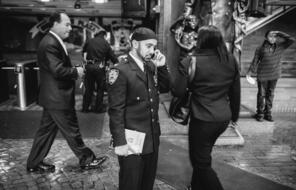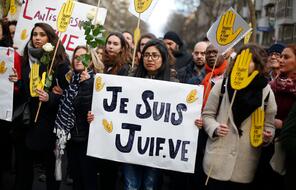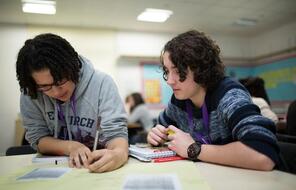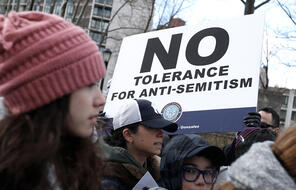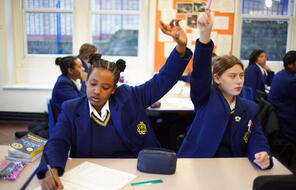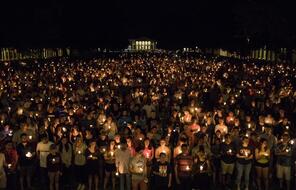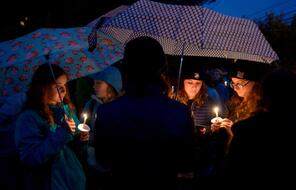Discussing the Israel-Palestine Conflict in the Classroom
At the present moment, Facing History and Ourselves does not have resources to assist educators in discussing the Israel-Palestine conflict in the classroom. We do, however, understand the importance of helping students navigate this challenging issue, and that when discussing contemporary Islamophobia and/or contemporary antisemitism, the conflict is likely to be raised by students.
Facing History and Ourselves UK is partnering with Solutions Not Sides (SNS), which ‘aims to tackle Antisemitism, Islamophobia and polarisation around the issue of the Israeli-Palestinian conflict in the UK’ 1 . For educators looking for assistance in discussing this conflict, we recommend reaching out to SNS, which has extensive expertise and experience in teaching students about the Israel-Palestine conflict in a way that promotes dialogue, empathy and conflict resolution. At the core of SNS’s work is a non-partisan programme of education that ‘has been formulated with the input of both Israelis and Palestinians as well as senior members of Jewish and Muslim communities, and is designed to prepare students to make a positive, solutions-focused contribution to debates on Israel-Palestine’. 2 The programme is split into three parts:
- Part 1: ‘Exploration’ – teaches students about historical narratives surrounding the conflict.
- Part 2: ‘Empathy’ – introduces conflict resolution and helps students reflect on the different needs of Israelis and Palestinians. This part features a film called Rage, Revenge and Repair, which was developed in conjunction with The Parents Circle – Families Forum, a joint Israeli-Palestinian organisation comprising people who have lost immediate family members due to the conflict.
- Part 3: ‘Empowerment’ – gives students the opportunity to ask Palestinian and Israeli speakers questions, and to discuss the pros and cons of different solutions to the conflict.
There is also optional follow-up work, which invites students to research a topic from a given selection in further depth and create a project based on their findings. The selection includes refugees, religion, nationalism, negotiations and activism in the UK, among others.
Additionally, SNS runs a Student Leadership Programme, which enables students to learn more about the Israel-Palestine conflict, receive training in conflict resolution, and affect positive change within their societies or communities.
If students want to discuss Israel-Palestine in further depth, it is important that you provide a safe space for them to do so as this can help students understand the complexities of the conflict and address any inaccurate information. Shutting down discussion can have detrimental consequences: in the era of smartphones, students have the Internet at their fingertips – they can therefore seek out information online, which might be riddled with inaccuracies, and might even be Islamophobic or antisemitic in nature. Moreover, if students feel like they are being unfairly censored, existing divisions in society can become further entrenched and it can actually lead to an increase in cases of antisemitism and/or Islamophobia.
Addressing this conflict in the classroom can also help counter prejudice and discrimination: any intensification in the Israel-Palestine conflict leads to a rise in religious intolerance and hatred, in which both Jews and Muslims across the world are singled out and targeted. In the UK, both Islamophobic and antisemitic hate incidents spike when there are outbreaks of violence in Israel-Palestine. 3 This is because some people protesting against the conflict do so using Islamophobic and/or antisemitic tropes, ideas and language. This is, in part, due to the fact that Islamophobes and antisemites exploit the situation, using it to further anti-Muslim and anti-Jewish sentiment; however, it is also down to the widespread circulation of antisemitic and Islamophobic tropes, which leads to some people who don't have antisemitic or Islamophobic prejudices using such tropes unknowingly when talking about the conflict.
Additionally, both Islamophobes and antisemites have been seen to deploy the tactic of ‘dog-whistling’. Some Islamophobes, for example, attack Palestinians and Palestine as a means of attacking Muslims everywhere without being charged with Islamophobia, while some antisemites attack the state of Israel as a means of attacking all Jews without being charged with antisemitism. Attention must, therefore, be paid to the evident overlap between the conflict in Israel-Palestine and Islamophobia and antisemitism, and the fact that, in some instances, those who express Pro-Israel or Pro-Palestine views do so to further religious hatred.
To help students gain an understanding of Islamophobic and antisemitic tropes, please see our units on contemporary Islamophobia (forthcoming) and contemporary antisemitism. And to help students understand how to talk about Israel-Palestine without falling on Islamophobic/antisemitic tropes and hate speech, please see SNS’s post Israel-Palestine: Avoiding Antisemitic and Islamophobic Hate Speech.
Recommendations for Discussing Israel-Palestine with Students
In addition to seeking support from Solutions Not Sides, Facing History and Ourselves UK recommends the following:
- Start with Yourself
- Know Your Students
- Create a Reflective Classroom Community
- Share Examples of Upstanding
1. Start with Yourself
Before discussing Israel-Palestine with students, it is vital to reflect on your beliefs, politics and emotional responses in relation to this conflict, and understand how they might impact your engagement with it. When educators start with themselves, they can help develop classroom communities that are centred around relationships and care, and in which students feel safe to discuss challenging issues.
Reflect on your relationship to this conflict using the following questions:
- What perspectives and experiences shape how I view the conflict in Israel-Palestine?
- Where did I first hear about it? How, if at all, did this shape my perception?
- How do I feel when I hear about this conflict now? What are the reasons I feel this way?
- How might my emotional response to this conflict be similar to or different from my students’ emotional responses?
- How might my feelings about the conflict affect what my students’ experience in my class?
- How might my students’ own identities and life experiences shape how they encounter this conflict?
- How can I create space in the classroom to discuss this conflict?
It is also important that you understand some information about the history of the conflict and of the region, and reflect on what impact discussing it might have on students in the classroom. We recommend that you read all of the SNS School Handbook, which can help to prepare you to discuss the conflict in the classroom.
We also recommend that you read our guide Fostering Civil Discourse: A Guide for Classroom Conversations, which contains strategies to help you navigate difficult conversations with students and tools that can help you create an inclusive community in your classroom.
You might also find the following articles/resources useful:
- ‘Israel-Palestine: Understanding triggers during dialogue’ (Solutions Not Sides)
- ‘Discussing Israel-Palestine: Creating safe and compassionate spaces for learning’ (Solutions Not Sides)
- Mona Boshnaq, Sewell Chan, Irit Pazner Garshowitz and Gaia Tripoli, ‘The Conflict in Jerusalem Is Distinctly Modern. Here’s the History’ (New York Times)
- Zack Beauchamp, ‘Everything you need to know about Israel-Palestine: A comprehensive guide to the basics of the world’s most controversial conflict’ (Vox)
- Afzal Khan and Alex Sobel, ‘Don’t let Middle East violence fuel hatred on the streets of Britain’ (The Guardian)
2. Know Your Students
Given the complex and difficult nature of the Israel-Palestine conflict, it is important to prepare for any discussion on the issue by considering how it might impact students in your class.
If you have a new class, we recommend that you discuss the content of the lesson with teachers who have previously taught the students to see if they know any reasons why this topic might be difficult for any of them. It is also worth speaking to the school counsellor or safeguarding team and informing them about the discussions that will be happening. You can ask them for support or even share the list of students who are going to be doing the lesson, to avoid triggering something without there being adequate emotional support in place. It is also important to tell students that if the lesson does impact them, they can come and talk to you or the school counsellor. To reflect further on which students might be affected by the conflict, see SNS’s Guide to Student Interest in Israel-Palestine.
It is also a good idea to give students advance notice that you will be discussing the conflict in a future lesson, as well as the chance to share their feelings about the topic with you privately before the lesson takes place. Doing so can create an opportunity to learn a little bit more about the feelings in the room and can help you understand if any students have personal connections to the conflict. The following questions could be shared with students on an Exit Card or on a piece of paper that you collect in for review:
- What impact, if any, does this conflict have on you?
- What questions do you have?
- Is there anything that you want your teacher to know?
3. Create a Reflective Classroom Community
Teaching Strategies
We believe that a classroom ought to be a microcosm of democracy – a place where explicit rules and implicit norms protect everyone’s right to speak; where different perspectives can be heard and valued; where members take responsibility for themselves, each other, and the group as a whole; and where each member has a stake and a voice in collective decisions. We recommend that teachers create a strong foundation for a reflective classroom through the use of the following:
Even if you have already established rules and guidelines with your students to help bring about these characteristics in your classroom, we recommend taking a moment to review how you might frame your classroom contracts and student journals within the context of discussing Israel-Palestine. It can be a good idea to revisit your classroom contract and consider how you will give students time for personal reflection as you cover the conflict.
To learn more about how to create a classroom contract, please see our Contracting teaching strategy and/or use our lesson Building a Classroom Community.
You might also wish to review our Teaching Strategies PDF, which collates a selection of strategies that appear frequently in our resources. At their core, all the strategies work towards creating a safe classroom space in which students feel respected, are able to learn from each other, and are encouraged to excel academically. This resource offers a variety of classroom strategies to develop critical thinking and communication skills, model democracy in the classroom, and empower students to become active, responsible agents of change.
Reflective Questions
You might also wish to consider using reflective questioning to help students understand diverse perspectives and reflect critically on their understanding of the world.
Topics/ideas for reflective questions include:
Differences in Perception
- Have you ever noticed a difference between how you view something and how someone else does? What was it? What do you think prompted these differences?
- Why do you think people view the world in different ways?
- What can be the positive and negative consequences of these different perceptions?
Stories We Hear/Are Told
Think about a story that you have heard/been told about. This could be in your family, at school, or in wider society.
- What is the story?
- In what situations have you heard it?
- How has it shaped you and your understanding of the world?
- Whose perspective is the story told from?
- Which perspectives might be missing from the story?
Collective Responsibility
- Have you ever been held responsible for the actions of others just because you share one or more identity traits and/or belong to the same group?
- What happened?
- How did the situation make you feel?
- What were the consequences?
- Have you ever held someone responsible for the actions of others just because they share one or more identity traits and/or belong to the same group?
- What happened?
- What prompted you to respond in this way?
- What were the consequences?
Perspectives and Conflict
Many conflicts are rooted in, and/or continue due to, differences in perspective.
- What factors contribute to people having differences in perspective?
- Why might these differences make conflict difficult to resolve?
- How can differences in perspective be overcome?
- What other examples can you think of throughout history, and in the present day, in which people have fought, or continue to fight, due to differences in perspective?
Land and Conflict
Throughout history, many conflicts have been caused by people fighting over land and territory.
- What are the consequences of conflicts over land and territory?
- What impact do they have on the lives of those living in disputed areas?
- Why are such conflicts difficult to resolve?
- What other examples can you think of throughout history, and in the present day, in which people have fought, or continue to fight, over land?
Power and Conflict
- What role does power play in conflicts?
- What methods do groups use to gain, and/or assert, power over others?
- What is the relationship between the impact of a group’s choices and actions, and the amount of power they possess?
- What other examples can you think of throughout history, and in the present day, in which people have fought, or continue to fight, to gain/maintain power?
Connect, Extend, Challenge
Once students have learnt information about the conflict, you can invite them to complete a Connect, Extend, Challenge handout, using the following questions to guide them:
- Connect: How do the ideas and information shared connect to what you already know about the conflict in Israel-Palestine?
- Extend: How does the information shared extend or broaden your thinking about the conflict in Israel-Palestine?
- Challenge: Does the information shared challenge or complicate your understanding of the conflict in Israel-Palestine? What new questions does it raise for you?
4. Share Examples of Upstanding
We recommend sharing examples with your students of people working together to create a peaceful solution to the conflict. There are a range of organisations working to this end in the region and across the world. Sharing information about them with students can help counter the divisive narratives that they are exposed to and instil hope, giving them the opportunity to reflect on ways forward. Solutions Not Sides has compiled a list of some of these organisations at the end of their School Handbook (pages 71–7).
- 1 ‘A critical approach to education on the Israeli-Palestinian conflict’, Solutions Not Sides (accessed 26 September 2022).
- 2Ibid.
- 3Lizzie Dearden, ‘Israel-Gaza conflict triggers spike in antisemitic and anti-Muslim hate in UK’, The Independent, 19 May 2021 (accessed 26 September 2022).



